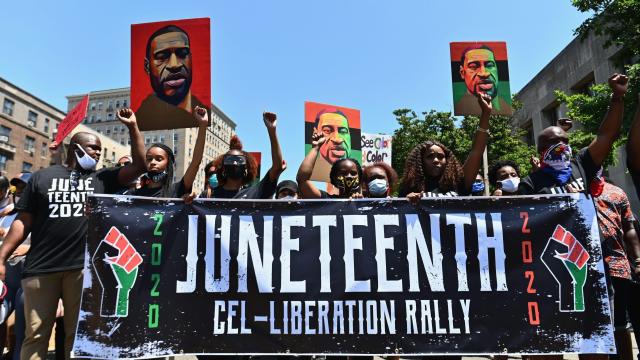Many of America’s most venerable traditions commemorate the country’s slow march away from its past. It’s a national history heavily defined by slavery, the stains of which still resonate today.
The 19th century was, in some ways, when the U.S.’s nascent trajectory veered from the path of barbarism toward something closer to ostensible equality. One of the most seminal days in that journey was June 19, 1865, known for over a century as Juneteenth.
What happened on June 19, 1865?
Juneteenth doesn’t evoke the same kind of grandeur as the Emancipation Proclamation, the document signed by President Abraham Lincoln in 1863 that legally mandated the freeing of all enslaved people in the Confederate States of the South. While Lincoln’s signature was historic and of seismic import at the time, it only carried symbolic weight when it came to Confederate border states that had slaves, but hadn’t formally seceded from the Union.
Two years later, however, Lincoln’s promise of liberation was realised in Galveston, Texas, when Union General Gordon Granger’s troops arrived in the city, freeing a quarter million from bondage in the heart of the chattel economy’s final stronghold.
What is Juneteenth?
If the Emancipation Proclamation was a statement of intent, formalising the free North’s ambition to shatter slavery and the economic juggernaut it bred, Juneteenth was the day the institution finally began to crumble for good.
As the Harvard historian Henry Louis Gates Jr. wrote for The Root in 2013, the Confederacy and its agrarian economy had been embattled in the years prior to Granger’s descent on Galveston, with its major cities, including the capital of Richmond, Virginia, lying in ruin after surrendering to the Union army in 1865. Because of the Union’s progress, the institution of slavery sought refuge in some of the border states — which allowed slavery despite not being part of the Confederacy — after the Emancipation Proclamation, which declared enslaved people in Confederate states free on January 1, 1863.
“Since the capture of New Orleans in 1862, slave owners in Mississippi, Louisiana and other points east had been migrating to Texas to escape the Union Army’s reach,” Gates wrote.
Many of these states operated in a kind of legal nether zone, in which slavery was slowly being rooted out in the Confederate states, but was still technically operating in the borderlands. Texas remained a bastion for slaveowners, with some 250,000 people still shackled in the state when Granger appeared with the 1,800 men under his command on June 19.
With the state fallen, the General delivered General Orders, No. 3, remarking that “the people of Texas are informed that, in accordance with a proclamation from the Executive of the United States, all slaves are free.” It was the Union Army spreading word of the Emancipation Proclamation — that the president had freed the innocent from their bondage.
As Gates notes, however, General Orders, No.3 didn’t cause slavery in the sate to crumble immediately.
On plantations, masters had to decide when and how to announce the news — or wait for a government agent to arrive — and it was not uncommon for them to delay until after the harvest. Even in Galveston city, the ex-Confederate mayor flouted the Army by forcing the freed people back to work, as historian Elizabeth Hayes Turner details in her comprehensive essay, “Juneteenth: Emancipation and Memory,” in Lone Star Pasts: Memory and History in Texas.
But these were the last embers of a dying institution struggling for oxygen, and six months later, in December 1865, the 13th Amendment was formalized, outlawing slavery across the United States.
How is Juneteenth celebrated?
A year after Granger’s remarks in 1866, Juneteenth’s first celebrations occurred when the recently free men, women, and children of Galveston commemorated the day with religious services and communal readings of the Emancipation Proclamation.
Since then, Juneteenth has been enshrined as one of the watershed moments in the broader story of Black liberation in the United States. It’s typically associated with “music, barbecues, prayer services and other activities,” per History, and has blossomed into a national pastime since the 19th century.
Is Juneteenth a national holiday?
Juneteenth isn’t a national holiday in the US, even as the wave of protest and social upheaval in the summer of 2020 compelled a broader segment of the corporate sector to observe it.
Still, the day is recognised by a vast majority of states in some capacity, while more than a third of Americans support making it a federal holiday, according to a new Gallup poll. The House and Senate have passed resolutions in favour of a federal Juneteenth holiday, but so far nothing has been formally codified by both chambers and the executive branch.
The momentum appears to be swinging in the right direction, with a greater share of the public more inclined to commemorate Juneteenth than ever before. So even as the federal government fails to give the day the recognition it merits, you can and should certainly pay tribute in any way you can, every year from now on.

Leave a Reply
You must be logged in to post a comment.